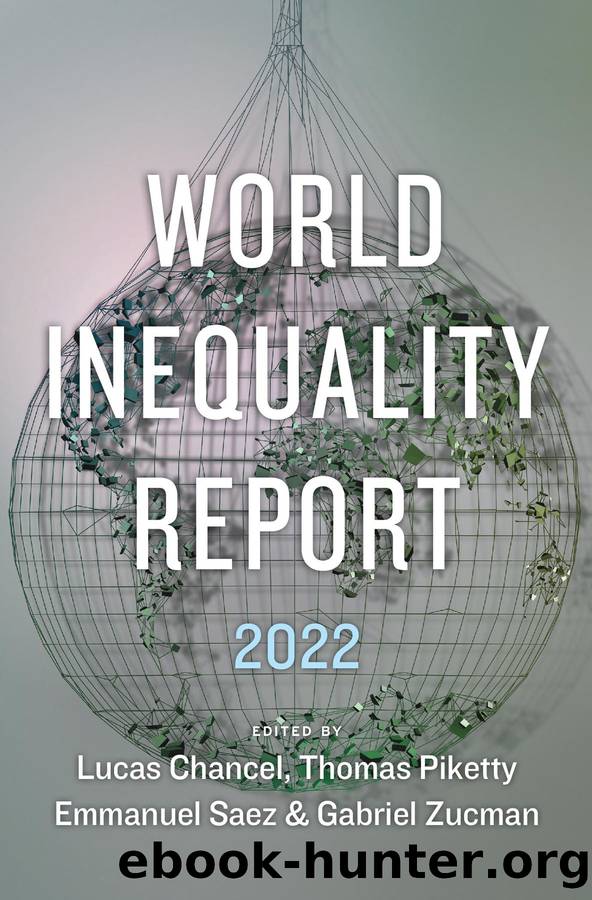World Inequality Report 2022 by Lucas Chancel

Author:Lucas Chancel
Language: eng
Format: epub
Publisher: Harvard University Press
Published: 2022-09-29T00:00:00+00:00
Figure B5.1Global gender inequality index, 1995-2019
Interpretation: There are 5-year intervals between 1995 and 2010, then 1-year intervals after that. Sources and series: wir2022.wid.world/methodology based on Human Development Report (2019)
Table B5.1 Multidimensional Gender Inequality Indicators across the world
Conclusion
To summarize, this chapter shows that income inequalities between men and women remain particularly significant both within countries and at the world level today, not only because of strong inequalities in pay differentials but also because of inequalities in types of occupation.
Most countries have increased womenâs share of national labor income since the 1990s. Exceptions are China as well as some countries of the former Eastern Bloc (Lithuania, Poland, Russia, Slovenia and Slovakia), wherein the female labor income share decreased from an already high level in international comparisons. The MENA region exhibits the lowest female income share with a value of 15%, while the former Eastern Bloc exhibits the highest at 41%.
Globally, the share of labor income accruing to women stands at slightly under 35% and has shown a positive trend over the past three decades, up from around 31% in 1990. At the same time, the average labor income share across countries, weighted by national population, was stable at around 28% over the period. Both indicators reveal that the female labor income share has remained strikingly low over the past 30 years: men earn approximately twice as much as women across the world, on average. Such indicators are arguably more telling than standard gender pay gap measures because they take into account systemic inequalities beyond pay differentials, such as inequalities in occupational type.
However, the dynamics we observe vary across countries. In Western Europe, North America, Latin America and the Caribbean, the slight increase in the female labor income share was mainly driven by womenâs increased participation in the labor market. In Asia, we observe that the earnings ratio has been on the rise. The MENA region shows a relatively high female earnings ratio, but low participation rates among women. This suggests that only highly paid women are selected into the labor market there. Sub-Saharan Africa, on the contrary, has a high female employment rate but a relatively low and stagnating earnings ratio.
Furthermore, the data reveal that women have increased their representation at the top of the wage distribution since the 1990s in many countries. Strikingly, while the US and France have a high representation of women among all wage earners, they lag behind in womenâs representation in top income positions. Brazil and Spain exhibit much higher shares of women in the top 10% and top 1% of wage earners than the US and France.
The persistence of strong inequality in access to good jobs and to good pay, as well as the negative trajectory observed in large countries over the past decades (such as China), explain why, despite some progress at the regional and country levels, the global female labor income share has not grown more rapidly since the 1990s. In the early 2020s, working-age women continue to earn about half as much as men.
Download
This site does not store any files on its server. We only index and link to content provided by other sites. Please contact the content providers to delete copyright contents if any and email us, we'll remove relevant links or contents immediately.
Cecilia; Or, Memoirs of an Heiress — Volume 1 by Fanny Burney(32385)
Cecilia; Or, Memoirs of an Heiress — Volume 3 by Fanny Burney(31759)
Cecilia; Or, Memoirs of an Heiress — Volume 2 by Fanny Burney(31728)
The Great Music City by Andrea Baker(31211)
We're Going to Need More Wine by Gabrielle Union(18914)
All the Missing Girls by Megan Miranda(15419)
Pimp by Iceberg Slim(14235)
Bombshells: Glamour Girls of a Lifetime by Sullivan Steve(13933)
Talking to Strangers by Malcolm Gladwell(13144)
Norse Mythology by Gaiman Neil(13140)
Fifty Shades Freed by E L James(13129)
For the Love of Europe by Rick Steves(12385)
Crazy Rich Asians by Kevin Kwan(9136)
Mindhunter: Inside the FBI's Elite Serial Crime Unit by John E. Douglas & Mark Olshaker(9113)
The Lost Art of Listening by Michael P. Nichols(7365)
Enlightenment Now: The Case for Reason, Science, Humanism, and Progress by Steven Pinker(7093)
The Four Agreements by Don Miguel Ruiz(6552)
Bad Blood by John Carreyrou(6483)
Weapons of Math Destruction by Cathy O'Neil(6090)
